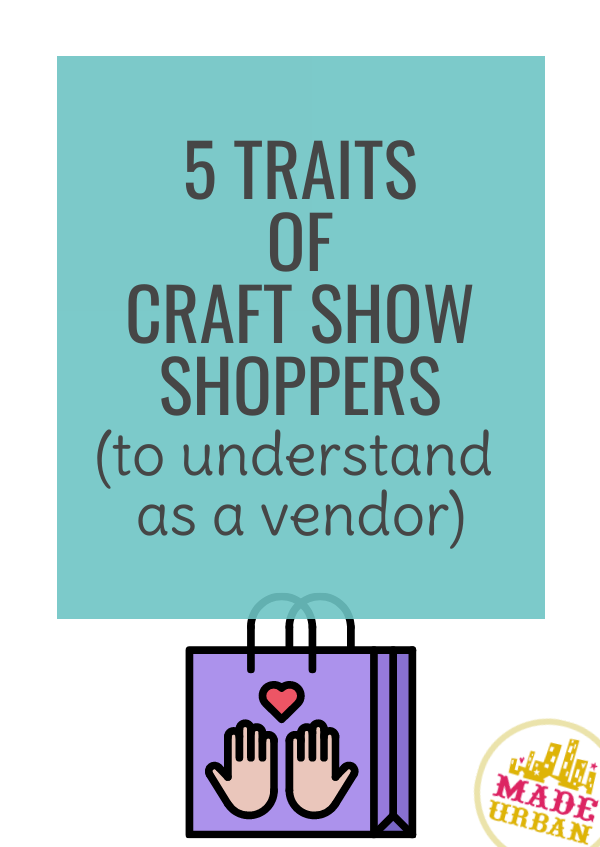5 Traits of Craft Show Shoppers
As a craft show vendor, it’s important to consider the typical traits and mindsets of those who shop at craft shows..
The more you can appeal to/align with/cater to them, the more successful you’ll be selling at craft shows and building a successful business.
There are always exceptions, but the following is more common among craft show shoppers:
1) Less mainstream
Craft show shoppers are typically looking for something unique and a little less mainstream.
They may feel underserved by the major retailers and appreciate smaller handmade businesses that create items that better fit their style/personality/lifestyle/etc.
Be sure to create products that show off your unique style, but don’t go too far out of the box.
Doing so can limit how many people will be interested in buying your products.
You don’t have to reinvent the wheel. Simply put a different spin on the products consumers are familiar with.
2) Conscious Shopping
These aren’t the same shoppers who crash the doors for the latest sale or product at Walmart/H&M/Sephora. Although they may have shopping excursions like this, it isn’t their mindset when attending a craft show.
They’re not going on a shopping haul, hoping to walk out of a craft show with heaps of products.
Craft show shoppers are more likely to be looking for one or two special items.
Find ways to make your products feel special and elevate them beyond mass-produced items.
Craft show shoppers also tend to be more conscious about:
- Where products come from
- What products are made from
- How products/packaging/businesses impact the environment
- The impact a business has on its local community
- etc.
Think about how your products contribute to your target market’s lives. Because most craft show shoppers aren’t just looking for another materialistic item to add to their closet/home/life; they’re looking for more value than that.
3) Low to mid price range shopping
Typically, craft show shoppers aren’t prepared to spend hundreds of dollars, especially not with one vendor.
But that doesn’t mean they’re looking for cheap prices.
A savvy craft show shopper knows they’re going to pay more for a handmade item, so don’t underprice your work.
However, $50 and under tend to be the more popular price points.
This can vary depending on the event. For example, fine art events tend to attract shoppers prepared to spend more money.
If you sell products that are in the higher price ranges, consider that you may need to use craft shows as more of a marketing channel than a sales channel.
These events will be your way to make that first contact with shoppers.
Offer some lower-priced items so they can walk away with something…and that something acts as a reminder for the higher-priced item they love and are saving up for.
For example, if I were selling large pieces of original artwork that are hundreds of dollars, I may not expect to sell those at the event. But I would offer my artwork in other mediums to offer items in that $50 and under price range. Such as printing my artwork on:
- magnets
- calendars
- stickers
- etc.
If someone loves my 4’ x 6’ original painting, but isn’t ready to spend hundreds that day, they might buy a calendar for $30. Each time they look at that calendar, it will remind them of the painting they’re saving up for.
Marketing material is also key.
Be sure to have:
- Business cards
- Newsletter signup
- Flyers (of upcoming events)
These will help you stay in touch with interested buyers.
4) Experiences
People who shop at craft shows are looking for a more unique shopping experience than the one they’ll get by going to the mall.
They want a cool story to tell.
Whether that’s simply about attending the craft show and the type of vendors/products they saw, or a story behind the product they purchased.
Be sure to interact with shoppers and tell them your story.
- What expertise do you bring to the table that they won’t get from a mass-produced item/big box retailer?
- What’s the inspiration behind your latest product line?
- What benefits do your products/business provide to customers?
5) Luxury items
The items found at craft shows aren’t necessities. No one needs another pair of earrings, bar of soap, or piece of art.
Handmade items are luxury items.
Luxury items are often desired because of their:
- exclusivity
- quality
- expertise
- branding
- social status
Keep these points in mind for the products you offer at craft shows.
Creating high-quality products for a specific target market and limiting how many are available can make them more desirable and help shoppers see them as a true luxury item.


Hey, I’m Erin 🙂 I write about small business and craft show techniques I’ve learned from being a small business owner for almost 2 decades, selling at dozens of craft shows, and earning a diploma in Visual Communication Design. I hope you find my advice helpful!
